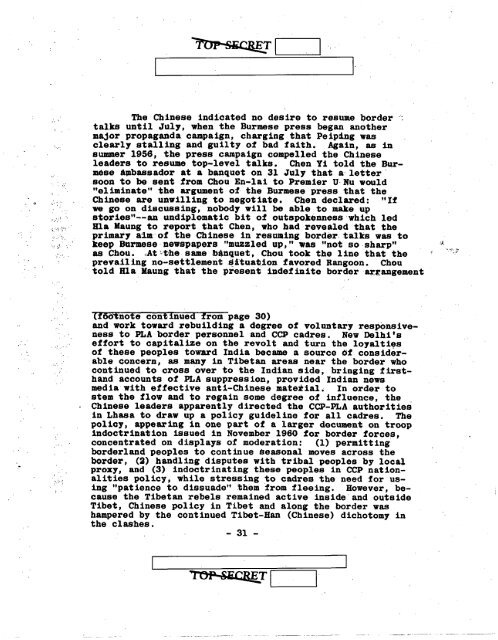The Sino-Indian Border Dispute Section 2: 1959-61 - The Black Vault
The Sino-Indian Border Dispute Section 2: 1959-61 - The Black Vault
The Sino-Indian Border Dispute Section 2: 1959-61 - The Black Vault
Create successful ePaper yourself
Turn your PDF publications into a flip-book with our unique Google optimized e-Paper software.
I<br />
I<br />
<strong>The</strong> Chinese indicated no desire to resume border -.<br />
talks until July, when the Burmese press began another<br />
major propaganda campaign, charging that Peipdng was<br />
clearly stalling and guilty of bad faith. Again, as in<br />
summer 1956, the press campaign compelled the Chinese<br />
leaders to re8ume top-level talks. Chen Yi told the Burmese<br />
tipbassador at a banquet on 31 July that a letter<br />
soon to be sent from Choa En-lai to Premier U Nu would<br />
t*eliminatel' the argument of the Burmese press that the<br />
Chinese are unwilling to negotiate. Chen declared: ltIf<br />
we go on discussing, nobody will be able to make up<br />
storieslw--an undiplomat ic bit of outspokenness which led<br />
Hla Yaung to report that Chen, who had revealed that the<br />
primary alm of the Chinese in resuming border talks was to<br />
i<br />
keep Burmese newspapers "muzzled up,'' was "not so sharptw<br />
< ,<br />
as Chou. ,At ithe same bgnquet, Chou took the line that the<br />
.= *<br />
.e<br />
prevailing no-settlement $ttuaaion favored Rangoon. Chou<br />
told Hila Maung that the present indefinite border wgymgement<br />
mo'tnote continued from page 30)<br />
and work toward rebuilding a degree of voluntary responsiveness<br />
to PLA border personnel and CCP cadres. New Delhi's<br />
effort to capitalize on the revolt and turn the loyalties<br />
of these peoples toward India became a source bf considerable<br />
concern, as many in Tibetan areas near the border who<br />
continued to cross over to the <strong>Indian</strong> side, bringing firsthand<br />
accounts of PLA suppression, provided <strong>Indian</strong> news<br />
media with effective anti-Chinese matekial. In order to<br />
stem the flow and to regain some degree of influence, the<br />
Chinese leaders apparently directed the CCP-mtA author it ies<br />
in Lhasa to draw up a policy guideline for all cadres. <strong>The</strong><br />
poliay, appearing In one part of a larger document on troop<br />
indoctrinaDion issued in November 1960 for border forces,<br />
concentrated on displays of moderation:<br />
(1) permitting<br />
borderland peoples to continue seasonal moves across the<br />
border, (3) handling disputes with tribal peoples by local<br />
proxy, and (3) indoctrinating these peoples in CCP nationalities<br />
policy, while stressing to cadres the need for using<br />
"patience to dissuade" ahem from fleeing. However, because<br />
the Tibetan rebels remained active inside and outside<br />
Tibet, Chinese policy in Tibet and along the border was<br />
hampered by the continued Tibet-Han (Chinese) dichotomy in<br />
the clashes.<br />
- 31 -<br />
I<br />
I<br />
I





![Combat Support in Korea [270 Pages] - The Black Vault](https://img.yumpu.com/49796461/1/190x71/combat-support-in-korea-270-pages-the-black-vault.jpg?quality=85)











